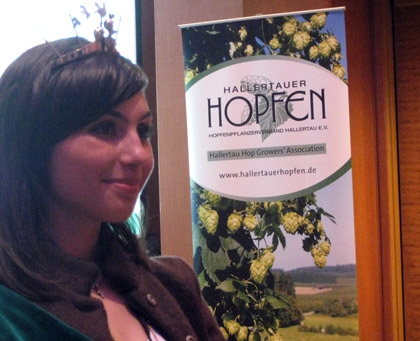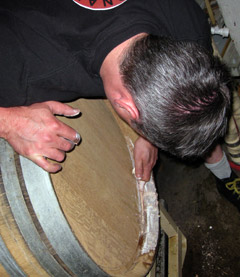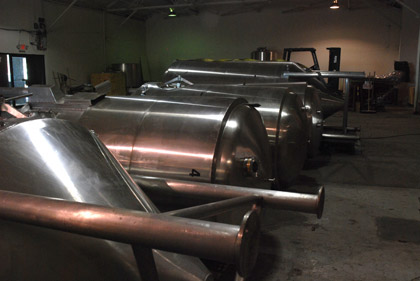This started as a comment within the conversation following the previous post, but when it hit the third paragraph I thought it better to start anew.
Perhaps I should have made myself clearer.
– This is the opposite of marketing. We now have a broader choice of beers — some obviously better than others, and some pretty terrible — because brewers did not, and still do not, listen to marketers who said/say drinkers will not buy beers with distinctive flavor (America in the 1960s and 1970s). Sierra Nevada Pale Ale never would have got out a focus group.
Which is not to say that some breweries aren’t trying to attract attention by promoting they have the beer with the most this or the most that.
– The Halltertau hop growers started coming to the Craft Brewers Conference in 2007, obviously to promote sales of their hops. They do this by bringing beers that showcase their hops. Eric Toft, who grew up in Wyoming but who has lived in Europe for more than 20 years and been brewmaster at Private Landbrauerei Schönram for almost a dozen, writes the recipes for the beers. Victory Brewing in Pennsylvania brews them because a) Eric has a long-standing relationship with Ron Barchet and Bill Covaleski, b) Victory has contracts for barley and hops with Bavarian producers, and c) the logistics of licensing and shipping.
The pale ale was not created to sell anywhere, but to illustrate to other brewers (mostly American) that Hallertau hops make an excellent addition to beers other than those intended to mimic those from Bavaria. Basing a recipe, let alone a marketing campaign, on my tastes would probably lead to disaster, but my opinion is they are right. I’d much rather try a new not particularly high gravity pale ale made with Saphir or Smaragd (two newer varieties) and one amped up on another addition of Northwest hops. I like those beers, but well-done versions exist and it seems to standout brewers feel compelled to simply dial up the flavor intensity.
Just my opinion, but I’m not sure you will find a better spokesperson for tradition in Germany that Eric. He pitches his yeast cooler and conducts primary fermentation cooler than most, automatically adding time to the production process. He uses only aroma hops, but makes some of the hoppiest (this is a relative thing) beers in Germany. That means more hops, more expense.
Workers at the brewery skim the fermentation every day (open fermenters, also a pain in the brewers’ butt) so the bitterness is more mellow. Schönramer Gold, which won a gold medal in the World Beer Cup, lagers 10 weeks. That’s after the longer primary. You really need to visit the brewery restaurant (it’s not far from Salzburg) because its the only place you can get Schönramer Pils and Dunkel unfiltered.
He believes that drinkers can taste the difference. Landbrauerei Schönram has doubled production since Eric took over (this wasn’t a start up; been around for more than 230 years). At the same time consumption in Germany has shrunk dramatically, so maybe he’s on to something. Just as Ken Grossman and Jim Koch were a while back and Alex Ganum is today.
– The new wave of beer drinkers are asking questions other than “which beer has the most alcohol?” or “which one has the weirdest ingredients?” Some ask just that, but also about where the beer is from, about the ingredients, about production practices. They talk about flavor, and want to try new ones — sometimes “extreme.” But here’s what you should really love about them, Mike. They drive marketers crazy. The don’t just advertisers make things up.

 Part Two. Beers aged in barrels, sour and otherwise. Attendees filled the chairs, lined up along all the walls and took seats in the aisles for Vinnie Cilurzo’s talk called “Toothpicks, Garlic and Chalk: Three Key Ingredients to Any Brewery’s Barrel-Aged Sour Beer Program.” (In the photo on the right Cilurzo is using those tools to plug a leaking barrel at the Russian River brewpub.)
Part Two. Beers aged in barrels, sour and otherwise. Attendees filled the chairs, lined up along all the walls and took seats in the aisles for Vinnie Cilurzo’s talk called “Toothpicks, Garlic and Chalk: Three Key Ingredients to Any Brewery’s Barrel-Aged Sour Beer Program.” (In the photo on the right Cilurzo is using those tools to plug a leaking barrel at the Russian River brewpub.)

 It doesn’t take much to encourage me, so a couple of comments following last week’s list of links means a linkorama this week. However, when I started this post I took a quick detour so the buncholinks will have to wait until tomorrow or the next day.
It doesn’t take much to encourage me, so a couple of comments following last week’s list of links means a linkorama this week. However, when I started this post I took a quick detour so the buncholinks will have to wait until tomorrow or the next day.